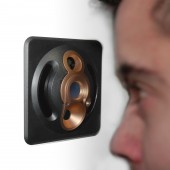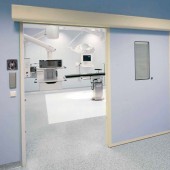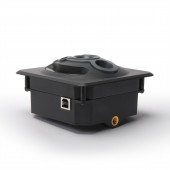DESIGN NAME:
FA2
PRIMARY FUNCTION:
Biometric Access Device to Unlock Doors
INSPIRATION:
The device was crafted to address a specific market demand for a biometric access device. Overall, the design and engineering goal was to beautify and simplify a complicated device while maintaining high functionality. The spherical shape is loosely inspired by the HAL computer light from 2001, which unifies the complicated 13 front facing components into a simple form. The two part front cover was an opportunity to add finely crafted aesthetic details to the product and increase functionality.
UNIQUE PROPERTIES / PROJECT DESCRIPTION:
A biometric device built into walls/ kiosks that captures the iris and entire face, then references a database to determine privileges. It grants access by unlocking doors or logging users in. User feedback features are built in for easy self alignment. LEDs and flash aid capture. The front has 2 plastic parts allowing duo-tone colors, the smaller drawing the eye with fine detail. The design simplifies 13 sensors into an aesthetic exterior. It is for corporate, industrial, and home markets.
OPERATION / FLOW / INTERACTION:
On approach, FA2 notifies users to check biometrics. For iris capture, users see the reflection of their eye in the cold mirror and LED distance indicator, aiding self alignment. IR LED light up EYE. Facial biometric image is also captured, using flash in low light. Data is sent to a PC where permissions are verified, and a signal is sent to either allow or deny access. Access can open locks or log in users.
FA2 installs like a common wall outlet. User registration can be done with tripod mount.
PROJECT DURATION AND LOCATION:
Industrial design and engineering for the project started in September 2009 in San Francisco, California (USA). Electronics and system design was started and completed in San Mateo, California (USA). Industrial design and engineering work was completed in March 2010 in Bristol, UK. Tooling was created in China and finished parts were completed in June, 2010. Products were tested in San Mateo, California and later assembled there. Products began shipping in August 2010.
|
PRODUCTION / REALIZATION TECHNOLOGY:
It was developed using sketches, CAD design, and prototypes. Parts were arraigned to optimize function, assembly, and aesthetics. A virtual face was even modeled to aim the sensors. Special care was taken to beautify and simplify exterior case of the internal parts. User features were added, including a mirror iris lens to self register and fine detail to draw the eye. Prototypes were used to refine the design. Parts are injection molded, lenses cut with water jet, and are hand assembled.
SPECIFICATIONS / TECHNICAL PROPERTIES:
Iris images are ISO/IEC 19794-6 compliant.
Face images are ISO/IEC 19794-5 compliant.
USB 2.0.
Integrated flash for face capture.
IR illumination for iris images.
Meets international Eye Safety Rules.
Distance sensor for improved focus.
Integrated cold mirror & RGB LED for easy user self alignment.
Integrated mic & speaker provides audio I/O.
Windows CE, XP, Vista, Windows 7 and Linux support.
SDK for custom applications.
Built-in tripod mount for desktop use.
4.0in x 4.0in x 2.25in and 8.5 oz.
TAGS:
biometric, iris, “facial recognition,” camera, facilities, access, industrial design, security
RESEARCH ABSTRACT:
Hardware research was to understand market and competitors, done via store visits and samples. An improved wall mount was a result. Market research was to understand if design was optimal for target environments. Images were combined with concepts to evaluate. A result was the sphere-like universal form. Another was color options for different markets. User trials improved intuitive usage. The feedback for self-registering, including colored LED, were a result of this research.
CHALLENGE:
The most difficult part was simplifying and beautifying the cover for the 13 complex sensors . They are densely packed and functionality was paramount. Additionally, it needed a friendly look for users who would bring their face close to the product. Allowing user to self align eye with the iris camera was another challenge solved during user trials. Internal fixtures for the many parts was challenging as well. Each sensor was aimed differently and required separate mounting points.
ADDED DATE:
2013-09-30 09:40:37
TEAM MEMBERS (2) :
Chris Dopp, Keith Grethen, Travis Baldwin and
IMAGE CREDITS:
Travis Baldwin, 2013.
|










